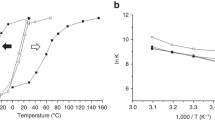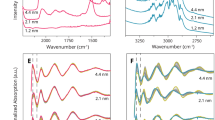Abstract
The catalytic properties of nanostructured gold catalyst are known to depend on the size of the gold particles and to be activated when the size decreases to a few nanometers. We investigated the size dependence of the three-dimensional nanostructure on the mean inner potential of gold catalysts supported on titanium oxide using electron holography and high-resolution electron microscopy (HREM). The contact angle of the gold particles on the titanium oxide tended to be over 90° for gold particles with a size of over 5 nm, and below 90° for a size of below 2 nm. This decreasing change in the contact angle (morphology) acts to increase the perimeter and hence the area of the interface between the gold and titanium oxide support, which is considered to be an active site for CO oxidation. The mean inner potential of the gold particles also changed as their size decreased. The value of the inner potential of gold, which is approximately 25 V in bulk state, rose to over 40 V when the size of the gold particles was less than 2 nm. This phenomenon indicates the existence of a charge transfer at the interface between gold and titanium oxide. The 3-D structure change and the inner potential change should be attributed to the specific electronic structure at the interface, owing to both the “nano size effect” and the “hetero-interface effect.”
Similar content being viewed by others
References
M. Haruta, Catal. Today 36, 153–166, (1997).
T. Akita, P. Lu, S. Ichikawa, K. Tanaka, and M. Haruta, Surf. Interf. Anal. 31, 73–78, (2001).
S. Tsubota, D. A. H. Cunningham, Y. Bando, and M. Haruta, in Scientific Bases for Preparation of Heterogeneous Catalysts edited by G. Poncelet et al. (Elsevier Science, New York, 1995), pp. 227–235.
R. Buhl, Zeitschrift für Physik 155, 395–412, (1959).
M. Keller, Zeitschrift für Physik 164, 274–291, (1961).
Y. C. Wang, T. M. Chou, and M. Libera, presented at Microscopy Society of America meeting 1997, Cleveland, OH, 1997.
M. Gajdardziska-Jpsifovska and A H. Carim, in Introduction to Electron Holography edited by E. Völkl, L. F. Allard and D. C. Joy (Kluwer Academic/Plenum Publishers, New York, 1999), pp. 267–293.
T. Akita, K. Tanaka, S. Tsubota, and M. Haruta, J. Electron Microscopy 49, 657–662, (2000).
J. C. H. Spence, Acta Cryst. A49, 231–260, (1993).
G. Radi, Acta Cryst. A26, 41–56, (1970).
M. Haruta, S. Tsubota, T. Kobayashi, M. Kageyama, M. J. Genet, and B. Delmon, J. Catal. 144, 175–192, (1993).
K. Tanaka, T. Hayashi, and M. Haruta, J. Japan Inst. Metals 60, 693–694, (1996).
Author information
Authors and Affiliations
Rights and permissions
About this article
Cite this article
Ichikawa, S., Akita, T., Okumura, M. et al. Electron Holographic Nano-Characterization of Gold Catalyst at Interface. MRS Online Proceedings Library 727, 22 (2002). https://doi.org/10.1557/PROC-727-R2.2
Published:
DOI: https://doi.org/10.1557/PROC-727-R2.2




